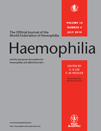Clinical efficacy and safety of the factor VIII/von Willebrand factor concentrate BIOSTATE® in patients with von Willebrand’s disease: a prospective multi-centre study
Abstract
Summary. von Willebrand’s disease (VWD) is an inherited bleeding disorder characterized by deficient levels of or dysfunctional von Willebrand factor (VWF). This phase II/III open-label, multicentre study evaluated the efficacy and safety of BIOSTATE®, a high purity plasma-derived double-virus inactivated FVIII/VWF concentrate, when used in non-surgical bleeds, surgical procedures and prophylactic therapy in VWD patients for whom desmopressin treatment was deemed ineffective, inadequate or contraindicated. Twenty three patients (7 type 1, 9 type 2 and 7 type 3; 12 male, 11 female), who received FVIII/VWF concentrate as part of their VWD management, were recruited prospectively between December 2004 and May 2007 from eight centres in Australia and New Zealand. BIOSTATE dosing was based on pre-treatment FVIII:C and/or VWF:RCo plasma levels and a predetermined dosing guide. Haemostatic efficacy of BIOSTATE was rated as excellent or good for all major and minor surgery events, long-term prophylaxis, and for four of the six assessable non-surgical bleeding events. Blood transfusions were required by two major surgery patients as well as one patient with a non-surgical bleed. The median overall exposure to BIOSTATE across all groups was 8 days, greater in the prophylactic group (range 53–197) compared with major surgery (3–24), minor surgery (1–8) and non-surgical bleeds (1–10). BIOSTATE was shown to be efficacious and well tolerated when treating patients with VWD. This study also provides important insights into dosing regimens with BIOSTATE and the role of monitoring therapy with FVIII:C and VWF:RCo.




